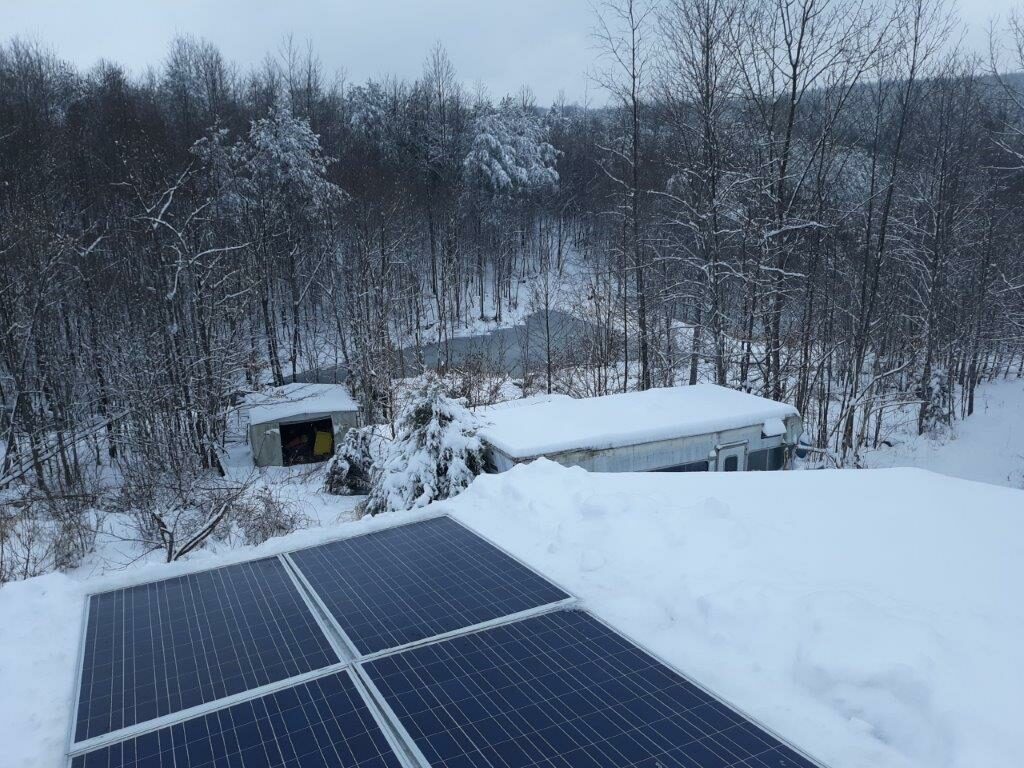
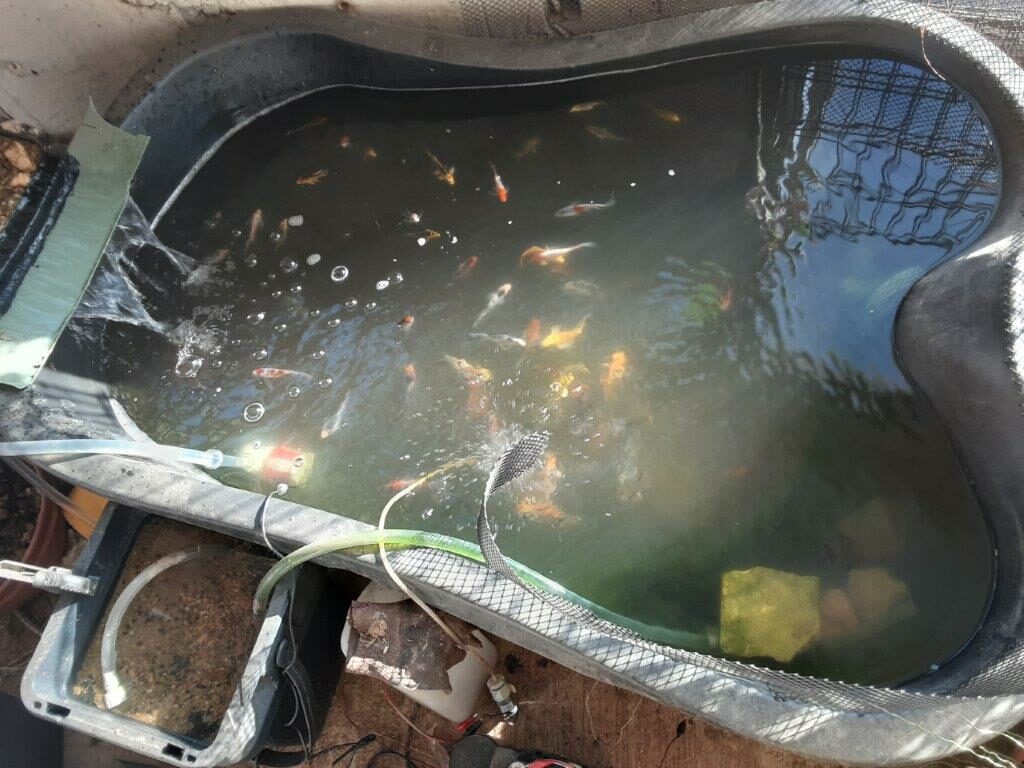
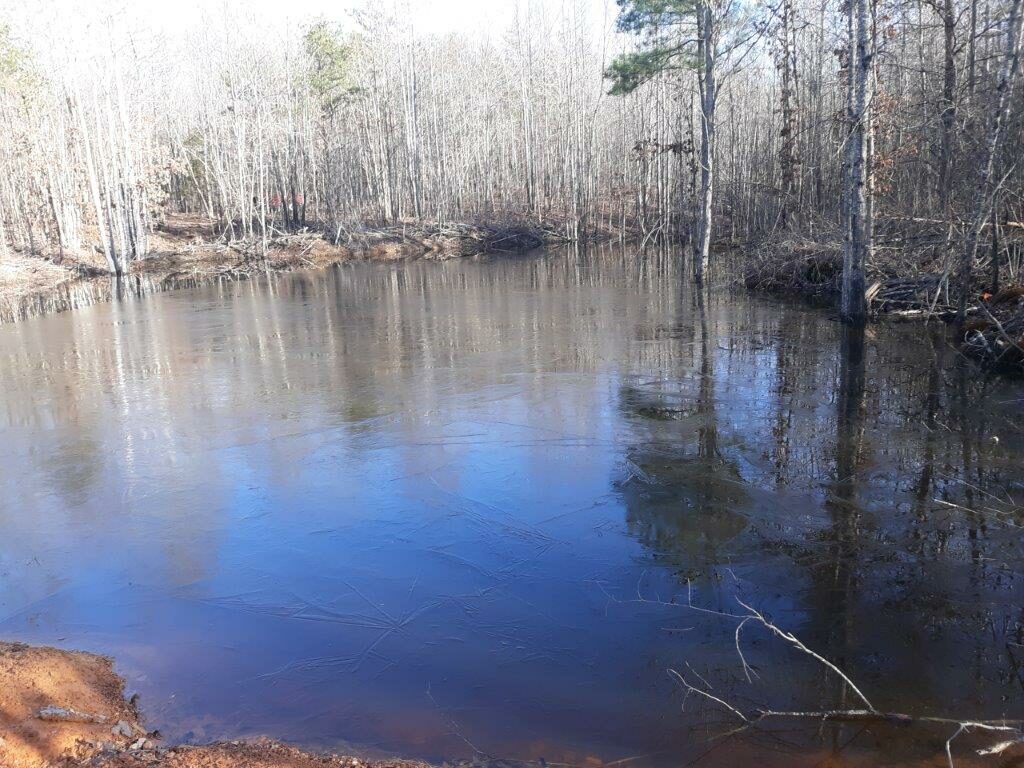
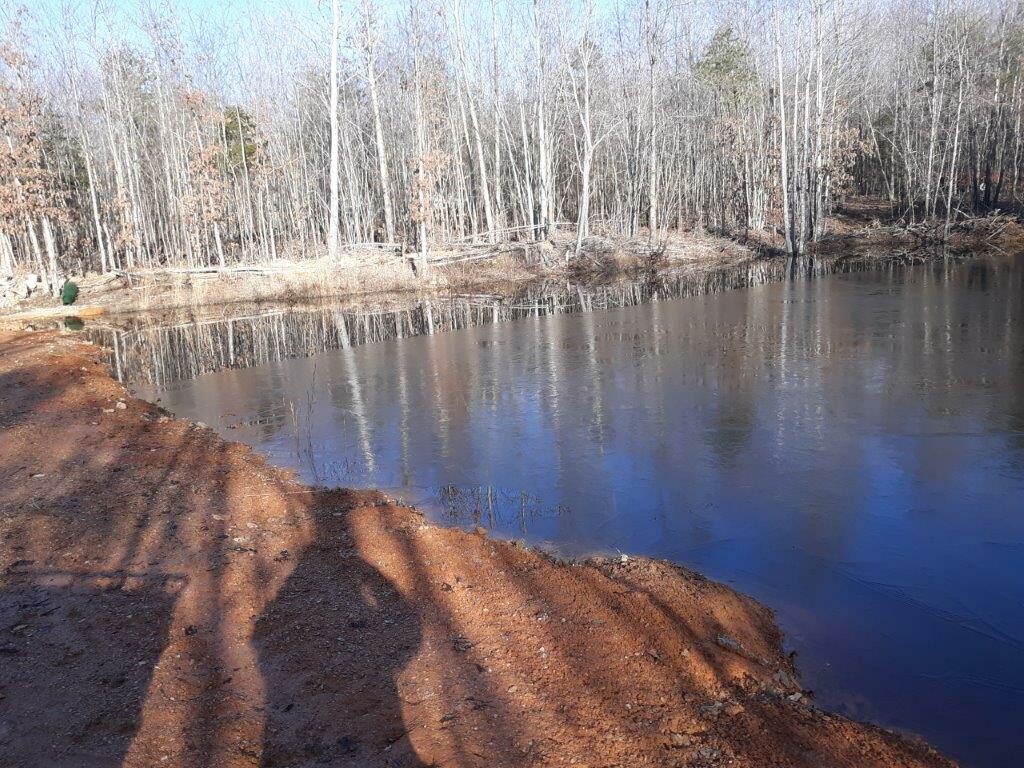
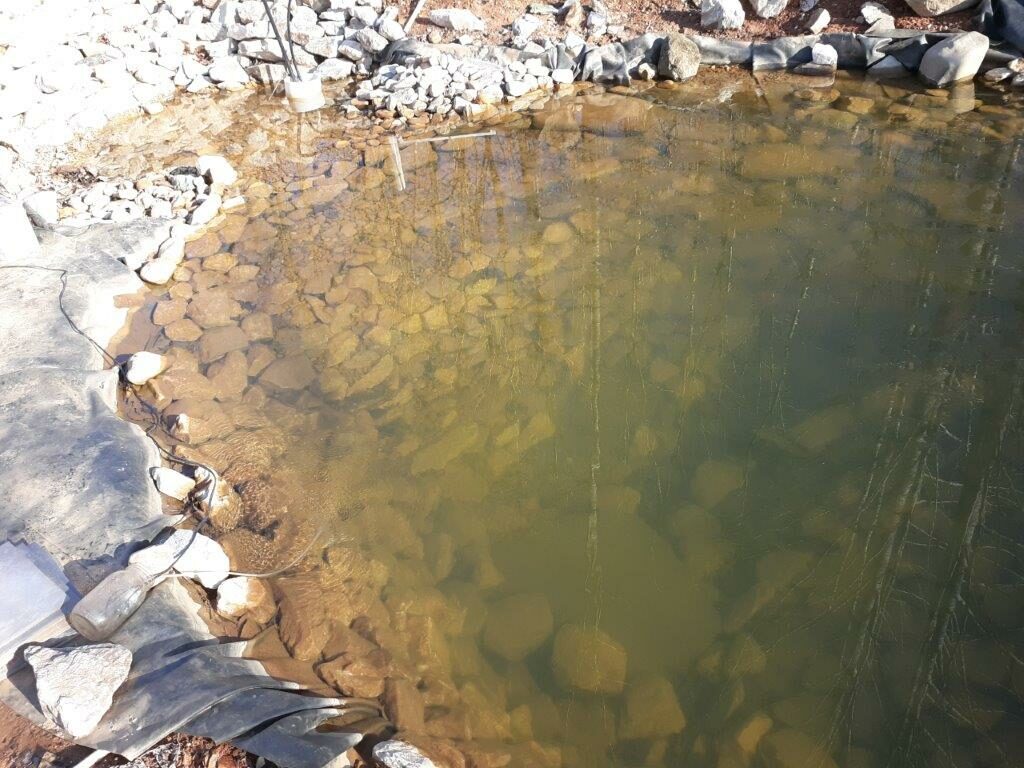
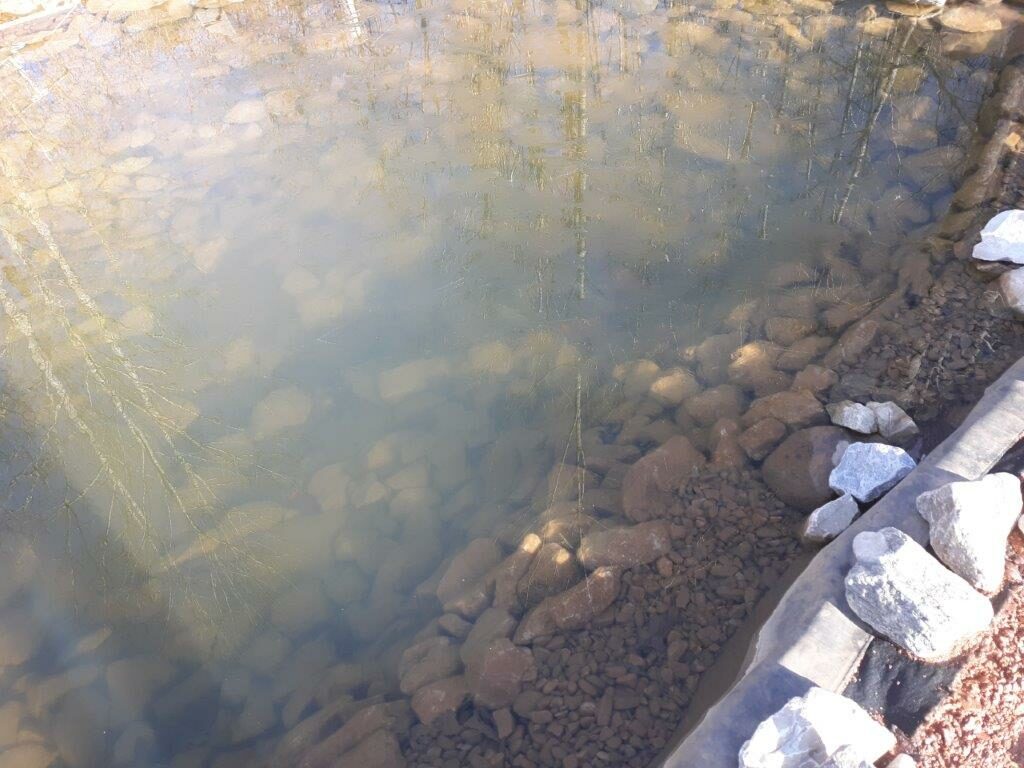






The roof is performing better in this new temporary state, and with strong winds and very heavy snow loads and lots of rain, it kept everything dry inside, although missing some fascia boards and gutters, I’m getting a fair amount of water accumulating around the foundation.
I could say I planned it this way to test my drains and bring them into good functionality, but the truth is that’s just a happy coincidence, because at the end of the gutters the water pours down and forms a lake right next to the lowest part of the earth around the foundation.
So with the heavy rains, the drains (after much modification, are finally handling water infiltration very well, although not without some sleepless nights sweeping water to the drain and chiseling deeper channels in the concrete floor- (I knew there was a reason I didn’t tile the greenhouse right away).
So now that the drains are really working, maybe it’s time to actually add some gutters and take all that water over to the actual planned destination, a pipe that goes under the driveway into the kitchen garden.
I have been upstairs rearranging, cleaning if you will, but really it’s just a warehouse, with space at a premium, and there’s only so much condensing and organizing a person can do before it’s time to let stuff go.
I’m inheriting a bunch of pretty nice stuff from my mom’s house, so it can replace the crap I was using, unfortunately it’s tough for me to throw away anything that’s still functional. So the skeletal additions to the roof are waiting for clear floor space around the miter saw as well as enough floor space to install the rafters.
I do have some high hopes that I might actually start to move forward on this project in the near future, especially since the first cleaning steps are mostly inside out of the weather. That reminds me, it’s nice out and I left some crap by the door that needs to go somewhere else. Stay tuned.
I have doubts that I will actually complete my roof this year. With summer heat and other projects the roof got put off and off until I got to the point where I had to do something so I could mount some new solar panels.
That something was to put down some plywood and fasten metal sheets down on top of it. So I can move and service these new monster panels .
The existing temporary covering on the roof had numerous leaks and actual open sky damage at times this past year and I knew I had to do something.
While the skeleton of the roof is mostly in place, the finished framework needs to be standardized with approximately 24 more rafters added before I can even think about actually finishing the roof . But I did at least get the mish mosh of materials off the roof and most of the metal in place so the next time I go to add plywood to the roof it will be easier to remove and replace the metal once I add the plywood. The missing skeletal elements can be mostly added from inside.
I could rant on about the hardships of working with salvaged materials, but the fact is I’m happy to be able to do so much with so little.
Now if I get back home after heavy winds and rain and find the place is still dry and the panels are still on the roof, I will be a very happy camper!:-)
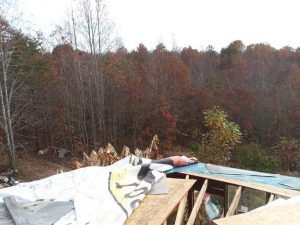 If it ain’t broke…. well, this was broke, out with the tarp, these first two roof sections are a bare beginning, with lots to do before they are in their final configuration, so you could say this is still temporary, but it definitely is moving toward a finished roof.
If it ain’t broke…. well, this was broke, out with the tarp, these first two roof sections are a bare beginning, with lots to do before they are in their final configuration, so you could say this is still temporary, but it definitely is moving toward a finished roof.
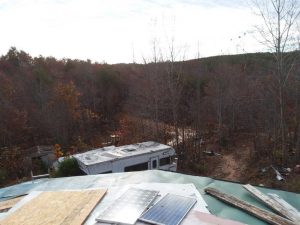 move the solar panels to the side ,slightly less power, but at least some continuity–these will be replaced with larger panels when this project is done.
move the solar panels to the side ,slightly less power, but at least some continuity–these will be replaced with larger panels when this project is done.
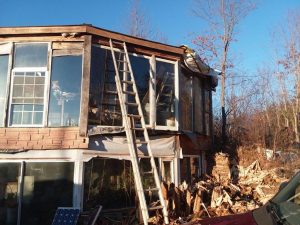 new fascia board helps to stabilize rafters
new fascia board helps to stabilize rafters
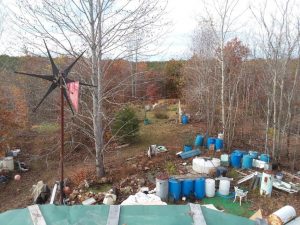 When I look around from this vantage the trash really jumps out at me. But in that “mess” is water storage, structural elements, tools and actual garbage. I know, get busy!!
When I look around from this vantage the trash really jumps out at me. But in that “mess” is water storage, structural elements, tools and actual garbage. I know, get busy!!
I was battening down for a big storm as Hurricane Irma approached and finally demolished the Keys and Florida in general. Today however, when the storm should be giving us a tropical deluge, I’m finding that there is even very little rain forecast for our area. I’m not concerned about water situation though, a quick check on the cistern last night, and it is filled, a tribute to the new gutter system. 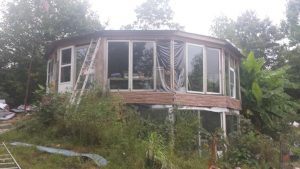 Also we will likely get more rain sooner or later, so that thousand gallons should easily carry me through to the next storm.
Also we will likely get more rain sooner or later, so that thousand gallons should easily carry me through to the next storm.
It’s somewhat interesting how all this recent work on the roof has triggered a new interest in getting the house to a place where it doesn’t need constant attention. Irma promised more water than she finally delivered, but it was enough to have me back on the roof for the last several days, while ignoring all the backhoe preparation I have to do.
Yesterday I finally started to set up the covering over the Yoke so the hatch would be more easily accessible, although the real test waits for the rain, and of course the final framing will get put off until the rest of the structure is substantial enough to really handle the extra weight.
At least now, my attention is moving down to the walls and inside the house in general. Organizing tools and materials, clearing a large section on the south side for actual living activities is the next big push. The rain gutters and fascia boards are almost finished, so now I can start looking at windows and framing and closing all the smaller gaps.
There is something about having a secure structure to live in that is basic to growth and development. I’m finding as I take care of things on a more permanent basis I’m more able to move forward with other parts of the process.
Simple details like secure bolts holding the headers together to stabilize the outer walls. Then that allowed me to lower the yoke and even out the roof structure which further stabilizes everything. And as each step progresses I feel better able to focus on and complete other details. The completion of the shelter may never be totally done, but longer intervals between working on it, and fewer nights waking up early to check for leaks or wind damage means more attention to other things, or at least more time to relax and be lazy.
Things like housing and other basic structures of our culture here in this place and time all seem to be up for grabs in deciding how much structure is necessary and how that structure will be implemented. Structure of course meaning everything we surround ourselves with.
Plumbing, transportation, food supply, etc have all taken on new qualities as we move forward with technology, and yet the newest technologies are still serving some of the simplest functions.
From tents to high rise luxury apartments, the goal is still the same, to protect us from the wind and rain. The real questions are, how much protection do we need and what is the cost?
August 24th
For whatever reason I woke in the middle of the night and never got back to sleep. So after much tossing and turning the light finally inspired me to get up–that plus Lucky whining at me.
So most of the day was tedious, although I was able to get a few things under control. The rain yesterday only seemed to leak in one place, not an obvious solution, but next time it rains I’ll pay attention to it. I continued painting the fiberglass panels, which are as bad as fiberglass insulation in many ways, with dust that sticks to the skin and is like hundreds of little needles. The paint seems to lessen that to almost nothing. Painting also will lengthen the life, waterproof, and strengthen the light weight panels.
Although I’m weaning away from the panels on the roof, they are actually quite useful and a quick coat of latex paint will not only help make them more waterproof, but will bind up the fiberglass dust and make them easier to handle.
The idea is that these are a resource that may be useful in future if they are maintained well now. They go on quickly, providing some structure and waterproofing and have proven invaluable in past temporary applications.
At any rate, the paint has been lying around for years now and needs to be used up, so this seems like a good way to do it.
I also was busy taking inventory and cleaning up outside, and did some studying of the inner roof structure, planning the next phase of the roof stabilization. It is easier to do repairs and fasten things where they belong now than it is in the middle of a snow storm.
Anyway, I did figure out how to proceed with the rain gutter installation, and tomorrow morning I’ll be setting up 3 or 4 sections of the roof with gutters going to the cistern. There are also several panels in the roof now that need to be moved around a bit. The work I did the other day means that the sections are all level with each other and panels can overlap from one section to the next. While I was arranging the flat boards as rafters the panels got moved around a bit also, so some were out of place anyway and a couple good winds could cause some problems.
In the cleanup I was not only bringing order to chaos, but getting rid of stuff, and the next trip to town I’ll have several boxes of stuff for the dump. I also was able to empty several of the big plastic containers and make a little more floor space here and there.
August 25, 2017
A little better sleep last night, I discovered the reason I was having trouble sleeping was because it was getting too cold, and in recent cleanups I had removed all the winter blankets to air them out. About midnight I went into the spare room and found a light summer blanket and slept till 5.
Cutting up trees around the upper pond, cleaning left over debris away from the edge and moving it all to the high water mark after the dam is finished this fall. Listening to one of the Permaculture course videos I was reminded that regulations in this over regulated world can have lots of ways around them.
On a small scale, pond dams can often be classified as erosion control devices, ponds can also be used in irrigation management and it is all true. This upper dam may in fact never hold water all the way through the seasons, but it certainly helps control erosion.
The fish pond likewise started out as a driveway crossing, and the fact that it holds water is a happy accident.
Anyway, wearing a jacket and leather gloves was a great way to work since it avoids so many cuts. And I made a pretty good dent in many of the chain saw cuts that needed to be made.
One of the first things I did on the house was get out another gallon of mistinted paint and paint more of the fiberglass panels. The first color was a dark pink, this made it much whiter. I’ve heard Seattle grey is the uniform color they make from all the old paint that is recycled there. I will likely add another gallon or two of whatever else I can find. There’s still lots of panels to paint, and I’m also painting those that are not in use.
I’ve been working on repairing the wheel of a lawn mower I just got back, and after two days using a wire brush and penetrating oil at periodic intervals the nut finally broke free with no damage to the wheel or the nut. A couple of really big washers to help stabilize the broken metal on the mower body, a few bits of tinkering to flatten and straighten the torn bits, and I was able to use one of the remaining holes to mount the wheel.
I started out filling the gas tank with diesel fuel accidentally, so had to dump that out and then refill with gasoline. I didn’t worry about getting all of the diesel out because that simply acts as a carburetor cleaner – or at least that’s what my uncle told me. He said during the gasoline rationing in world war 2 they use to regularly mix their gas with diesel to stretch their ration. He said except for the extra smoke it worked just fine.
Anyway, once I got the mower started I didn’t want to stop it, so I spent the next half hour cutting paths through the tall grass. If the wheel is still in good shape there’s a meadow to cut that is starting to see some volunteer trees moving in.
I was up on the ladder and the roof, and will go up once more to see if I can get those boards cut right on the first section so I can install a fascia board. We have at least two more days forecast as even cooler weather, perfect for that sort of work. I also found the section of gutter that adapts to the downspout, so at some point I’ll be ready to power through the details and install it, but for now I’m content taking my time making small steps getting ready.
There’s also always a bit or two that needs to be carried to the trash or put in the right place. The object is to continue to create space and get rid of junk.
August 26, 2017
Last night before dusk I went ahead and cut the secondary rafters to allow the placement of a fascia board, quite a lovely sight to see the ends tied together in a more professional manner, and the next step will be extending the fascia on at least three more sides.
Since the work needs to be completed on this water collecting feature, I’m already thinking about how to cut the angles for the rain gutters. With non traditional designs like this one all the fittings need to be custom made. I have some experience with this from cutting rain gutters for the octagon, and expect these to be reasonably straightforward, and likely I can manufacture the critical cuts and joining on the ground, and have only one or two angles to assemble from the ladder. I can already hear the next batch of rainwater running down the spout into the cistern.
After the trip to town I’ll be looking forward to cutting grass, fitting fascia boards, cutting trees, clearing debris, and cutting and fitting gutter angles. But for right now I think it’s time to walk around and find rain gutters and hangers so I know if I need to buy anything.
August 31, 2017
A lot has happened since I last wrote. Fascia and gutters on 6 sides, general cleanup and work on pond sites.
Today however was a real dooser although it started out very straight forward clearing more debris from the high pond expansion area, then little bits and pieces of cleanup, visit to a friend, then decided to cut the grass around the walnut tree at my neighbors house.
After most of the critical grass under the tree had been cut things got ugly and ended up with me being chased a considerable distance by ground nesting yellow jackets and leaving the lawn mower there running.
The first thing I did immediately after getting back to the house was take a couple eye dropperfuls of echinacea extract internally. Then I showered and decided more decisive therapeutic action might be required.
I remembered hearing that sometimes being stung over and over can cause more severe reactions each time and with the recent history of a similar incident a couple weeks before I was somewhat nervous that something more serious might happen. So I gathered up my blender and a load of fresh plantain leaves and headed back to my neighbor’s house.
We mixed in a bit of water and liquified the plantain leaves, then he went over my back and arms and with bandaids secured the plantain poultices in place. I think he counted 10 bandaids after most of the stings were covered. One sting in the middle of my head and another on my eyebrow were deliberately left without bandaids.I noticed on the way back home that the lawn mower had finally run out of gas, but no way I was going after it yet.
I did stop and look a bit to try and see where the swarm seemed to be, but left my hat on the ground where it fell off when I was running, about 15 feet away from the nest. That was still closer than I wanted to get. They get a visit tonight after dark and I’ll get the mower and if possible pour a couple gallons of urine on the nest. I may wait however for the next rain storm to make sure they are not flying.
Later I noticed that where I was stung on my eyebrow was very sore, so I put some of the leftover poultice we prepared in my hand and held it on my eyebrow for 15-30 minutes and notice now as I write that most of the ache/pain has gone from it. There’s also a spot on top of my head that could probably do with a bit more poultice as well.
September 1, 2017
Well, all the owies have turned into itchies or gone away completely, and this morning I took my first hot shower since I shut down the rocket stove in the Spring.
The outside temps were cool this morning, and with most of the heat going into the water there should be no problem with overheating inside now. Plus I decided some hot water might relax some of the tension generated by all the recent work and stings my body has been through.
The rocket stove performed perfectly up to specs. It has been two years in this configuration, although each year I think I want to add some insulation to the heat riser, clean and do a visual inspection inside the barrel. For now it seems to be in good condition, and the only thing I might do is rebuild the fire box.
Repairs and maintenance are easy on the clay portions of the stove, and I keep a bucket of fresh sifted clay nearby just for the odd occasion when the mood strikes and I decide to smooth a surface or repair a crack. Right now there are some non critical cracks around the fire box because it originally was built with a glass front.
Even though the glass was from a fireplace enclosure, it was not up to the heat generated in the stove, and quickly shattered. I had replaced the glass with fire brick, and did a quick patch around the edges with clay, but those repairs are a bit under the weather now and showing signs of wear.
The fire box takes the most abuse of any part of the stove, and while not the hottest part of the stove, temps there can reach 700 degrees F.
The copper coil that heats the water really does need to be upgraded, but I will save that project for a more peaceful time when I can give it my full attention.
I am still toying with the idea of waiting for next year to rent the back hoe again.
If I do that it will mean some sort of intermediate work on the low gully dam to bring the whole length high enough to push excess water out the spillway. Seems like it may be time to do some observation and thinking about possibilities.
No time like the present!
Ok, so maybe it wasn’t really such a thrill when that last rafter locked itself in place, but it certainly started the wrap up of work on the roof and upstairs in general for this season.
As you know if you’ve read earlier posts, I have dozens of different areas to work in, each one of them having some sort of crisis or other at different times. Gardens were planted more or less on time, but I couldn’t give them near enough time. I managed to build a few new raised beds, but there was still lots more that could have been done. Starting a few new perennials in the food forests and gardens are ongoing projects.
Hand work on the dams was a main time consumer for a while, sorting through clay, rocks, wood and getting the clay onto the top of the dam. Both expanding the swale systems and fortifying the dams remain primary concerns. Preparation of areas for the backhoe, clearing brush and trees, surveying swale lines, and cleaning away debris from other areas all remain as projects to complete before the fall.
So even with the urgency of a better roof system, the Main Frame Water Design is still the project that is most on my mind and the limiting factor on how much more time can go into the upstairs and the roof. The water design requires time to mature, and incomplete dams invite setbacks, so if the roof rafters being fitted in place was exciting, getting all the dams up to height, with swale systems planted and functional will be an ecstasy that goes on for a long time.
Looking at the back of the building where the water collection was, reminds me of the many more roof elements that have yet to be completed and that I will need to get a new collection system installed before the winter. Right now the rain barrel at the lower greenhouse supplies most of the water, temporarily taking pressure off the cistern, and there is a backup pump at the spring which can supply water to the cistern, but, having the house back functioning as the primary collector is really ideal
As my energy starts going back toward the water design most of the roof will still rely on temporary elements and those elements will need some ongoing attention. With fiberglass panels that are deteriorating rapidly, a tarp with many tears and holes, and Tyvek as the current covering, they will all need to either be replaced or reinforced over time, and while this last mild rain only produced a couple leaks, I know for sure that the first really strong wind could expose large areas to the rain.
Then there are the finer points of roof construction, the eaves and gutters and all those things that really make a roof permanent and maintenance free.
Yes, I’m happy about being able to make the step to a better roof structure, but overall the roof remains on the list as one of many works in progress. Once a good permanent structure is in place, the roof can disappear altogether as an energy drain .
I’ll start with some descriptions and pictures, and follow with a more detailed work diary.
This structure was a 12 sided polygon with two temporary walls running across the structure about 8 feet apart, dividing the yurt into three parts. The back and side walls were originally set at 8 feet tall and the back central temporary wall was set at 10 feet tall with a rectangular sloping roof overhanging the back part of the structure.
The front central wall was set at 8 feet and had a sloped roof connecting to the 10 foot wall and covered the central part of the building. The last section of the temporary roof to be built included a design change to exterior walls in front that used 80 inch studs, just tall enough to accommodate a standard door frame. That part of the roof was less than half the slope of the other sections.
The new roof would eliminate internal walls with rafters running like spokes in a wheel from a central yoke to the outside walls. with a rise of 2 feet for 12 feet of lateral distance
Here’s some Pics
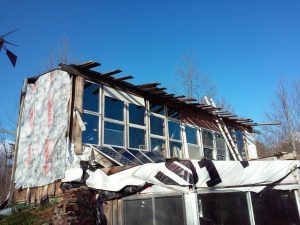 Middle and back sections of temporary roof.
Middle and back sections of temporary roof.
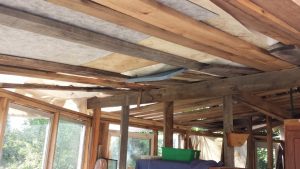 The south (front) temporary section was put up the following year. This is the front temporary roof section. The temporary roof here uses the tarp that was previously covering the floor before the outside walls were put in place
The south (front) temporary section was put up the following year. This is the front temporary roof section. The temporary roof here uses the tarp that was previously covering the floor before the outside walls were put in place
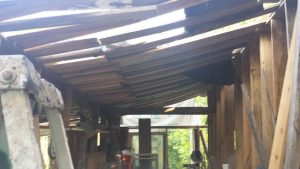 First half of the center section with roof being removed. The 10 foot walls on right, 8 foot walls on left. At the far end note the space between the board just over the door, and another horizontal board higher up, this is the difference between the original design height of the outside walls and the final height that all walls had to be brought down to.
First half of the center section with roof being removed. The 10 foot walls on right, 8 foot walls on left. At the far end note the space between the board just over the door, and another horizontal board higher up, this is the difference between the original design height of the outside walls and the final height that all walls had to be brought down to.
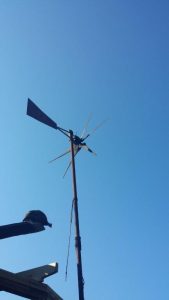 Lucky enjoyed playing on the roof, this extension of the 10 foot central wall was dismantled shortly after this picture. I remembered the evening I had to climb on that part of the roof at twilight to get her down from her perch on the windmill .
Lucky enjoyed playing on the roof, this extension of the 10 foot central wall was dismantled shortly after this picture. I remembered the evening I had to climb on that part of the roof at twilight to get her down from her perch on the windmill .
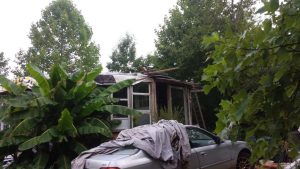 the front (south) section of the temporary roof had a tarp that conformed to the curvature of the walls.
the front (south) section of the temporary roof had a tarp that conformed to the curvature of the walls.
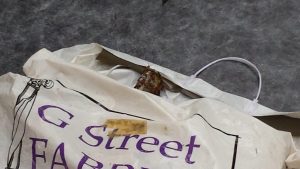 These guys (brown wasp nest center of picture,)surprised me, but did not sting. Getting up very early on cool damp mornings proved to be the best way to handle them. Many wasps were moved outside, and most of them survived to tell the tale. No poisons had to be used, and while I did get stung a couple times during the whole project, the ironic thing was that I was stung many more times and far worse while weeding around a comfrey transplant in the food forest by ground wasps.
These guys (brown wasp nest center of picture,)surprised me, but did not sting. Getting up very early on cool damp mornings proved to be the best way to handle them. Many wasps were moved outside, and most of them survived to tell the tale. No poisons had to be used, and while I did get stung a couple times during the whole project, the ironic thing was that I was stung many more times and far worse while weeding around a comfrey transplant in the food forest by ground wasps.
As often as I encountered the mud daubers and paper wasps, and as many times as I surprised them (or they surprised me ), mostly they just buzzed at me and let me know they were unhappy. The truth is that I am starting to develop a genuine fondness for some (though not all) of these guys.
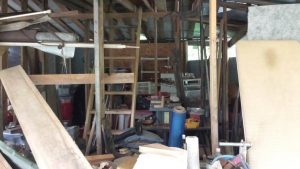 As I look at this picture there was probably some construction detail I was trying to record, but now all I see is a huge mess.
As I look at this picture there was probably some construction detail I was trying to record, but now all I see is a huge mess.
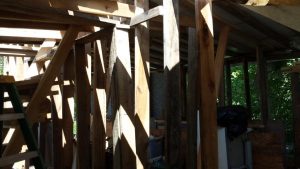 Half the job is just getting rid of the old structure
Half the job is just getting rid of the old structure
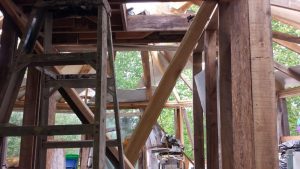
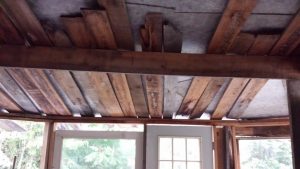 This picture is a great demonstration of the total disregard for planning or permanence when rain is imminent, just throw up some supporting walls, lay any wood you have laying around on top of it and cover it with anything you think might be waterproof. Let the wind and the rain tell you where/when to reinforce or do better. this particular roof only was in use for two days of rain.
This picture is a great demonstration of the total disregard for planning or permanence when rain is imminent, just throw up some supporting walls, lay any wood you have laying around on top of it and cover it with anything you think might be waterproof. Let the wind and the rain tell you where/when to reinforce or do better. this particular roof only was in use for two days of rain.
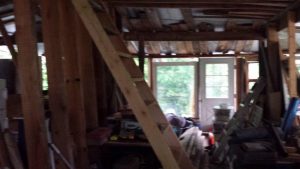 the center of the yoke will need frequent access and a stairway that may become part of a more permanent feature in the finished house takes shape
the center of the yoke will need frequent access and a stairway that may become part of a more permanent feature in the finished house takes shape
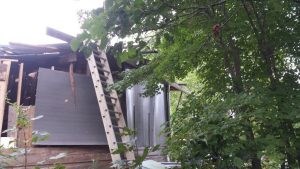 back wall of house-to the right of the ladder is the downspout that took rainwater to the cistern. The back section of the temporary roof had a rectangular frame with overhanging sections beyond the actual walls of the house
back wall of house-to the right of the ladder is the downspout that took rainwater to the cistern. The back section of the temporary roof had a rectangular frame with overhanging sections beyond the actual walls of the house
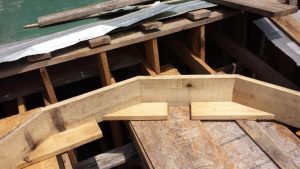
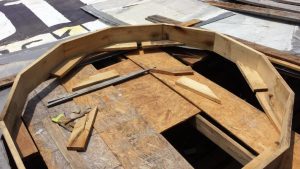 These are pictures of the yoke being assembled on a temporary work platform
These are pictures of the yoke being assembled on a temporary work platform
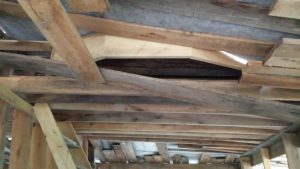 looking up at the yoke in the middle of a jumble of temporary supports
looking up at the yoke in the middle of a jumble of temporary supports
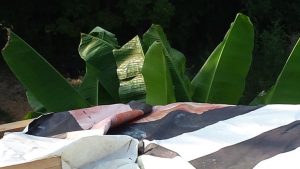 the old roof tarp being moved to one side getting ready for new rafters. After the new rafters were installed, a couple fiberglass panels went down and the tarp was moved back.
the old roof tarp being moved to one side getting ready for new rafters. After the new rafters were installed, a couple fiberglass panels went down and the tarp was moved back.
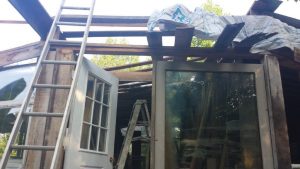 The long board sticking out beside the top part of the ladder will have to go-it was part of the temporary wall and in the way of new rafters.
The long board sticking out beside the top part of the ladder will have to go-it was part of the temporary wall and in the way of new rafters.
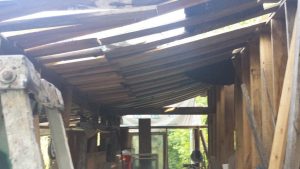 middle section with roof being uncovered
middle section with roof being uncovered
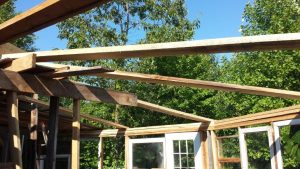 Getting the main rafters laid out in place. Note the top wall plates are actually 4 separate 2×6 boards, installed flat, but with an overall height of 7 inches. These overlap and are bolted together forming a continuous structural element called a tension band.
Getting the main rafters laid out in place. Note the top wall plates are actually 4 separate 2×6 boards, installed flat, but with an overall height of 7 inches. These overlap and are bolted together forming a continuous structural element called a tension band.
This band also acts as a header around the entire structure allowing placement of windows and doors to be easily changed. Working with second hand doors and windows upgrades can be easily installed if dimensions change.
All the studs are installed with toe nails (construction screws) making the changes even easier. All holes are predrilled to prevent splitting
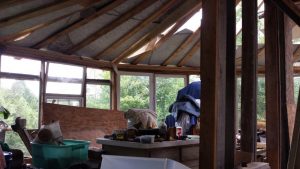 The roof may look lots better, but the flat boards in the roof are still temporary. Likewise the flimsy fiberglass panels will need to be replaced soon.
The roof may look lots better, but the flat boards in the roof are still temporary. Likewise the flimsy fiberglass panels will need to be replaced soon.
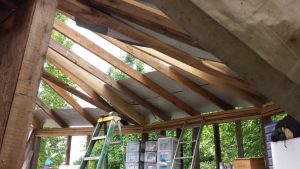 The last day was a monster of getting stuff done once all the rafters were seated. It took almost half the day to make those final connections, and there was way too much to do to try and get a finished roof. In fact, getting this primary structural change in place is just the first step. Individual sections will need to have soffits and permanent secondary rafters cut and properly installed with gutters and well fastened metal roofing.
The last day was a monster of getting stuff done once all the rafters were seated. It took almost half the day to make those final connections, and there was way too much to do to try and get a finished roof. In fact, getting this primary structural change in place is just the first step. Individual sections will need to have soffits and permanent secondary rafters cut and properly installed with gutters and well fastened metal roofing.
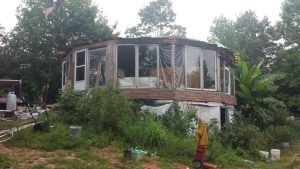
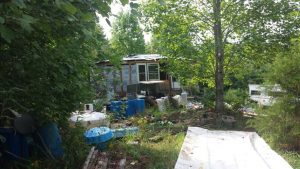
Construction Diary
July 20, 2017
This morning I spent a fair amount of time just observing everything, and in the process saw some things that I think may be important in the actual dismantling of the existing roof and establishing the framework for the new one. So I installed some braces without actually uncovering anything.
I also freed up some space near some of the walls that were obstructed, got rid of another wasp nest and then found several more that will have to go also. During some of the down time in the extreme heat of the day I was able to work with the Computer Assisted Design program and got a much better set of dimensions for the main rafters, and I also went ahead and did the first cut on all 12 of them (even though I’ll only need 8 during this phase).
If the weather cooperates I should have two reasonably cool mornings to go ahead and remove the old structure and then cover everything back up quickly before the rains Friday night.
July 21, 2017
I just came down from the roof, been up a little over 3 hrs with some breaks, only about 10AM now, but the heat is amazing.
Looking over the progress from yesterday things look much different. Most of the old temporary roof has been removed on one side, and the center has been framed up with a scaffold directly under the Yoke (center hub of the roof of a Yurt).
The fiberglass panels came off pretty easily and have been put back down temporarily in a new configuration to deal with expected thundershowers. Today I have already built a fairly substantial stairway (glorified ladder) that comes out in the middle of the yurt which will make access to the roof much more direct.
Trying to even up the yoke is proving to be a little tedious, and with the heat I finally just gave up altogether. But I will go back up and start cutting the other ends of the main rafters. 12 fairly complicated cuts and they will have to be moved around, so that will take a fair amount of time, but at least the project is moving forward.
July 22 2017
Grocery shopping this morning, then retreated inside and napped for about 4 hrs. Maybe also a bit worn out from being stung multiple times after disturbing ground hornets while pulling weeds. The stings kept me awake last night, and several hrs I was massaging and cleaning the stings with Echinacea tincture
and trying to find that magic combination that would let me get back to sleep.
I did go up and make another cut on each of the 12 rafters and now all that remains is to start the generator and make another 12 heavier cuts to get them all ready to be installed.
I’ve also been moving the top plates for the walls to where they will be needed and found several spikes that will hold those heavy plates in place when I go to set the rafters. I have that all scheduled for Tuesday when it looks to be cooler with less chance of rain, and in the meantime I can continue clearing access routes and gathering materials.
The critical next step is to get the Yoke perfectly aligned and stabilized, and finalize the connection method with the rafters. I am fairly certain it will involve very precise cutting of internal braces that will give a strong back to hold bolts to keep the rafters firmly attached.
A friend of mine recognized the actual stresses on Yurt construction all tend to push the rafters in toward the Yoke and actual support comes from the walls, so the real force needed at the center is to keep the rafters from popping up or sideways at that joint.
The plan is to get the south three rafters in place and a good roof structure there to allow for water proofing and placement of solar panels. This will free up the other side of the old roof so it can be dismantled and then made ready for the new structures.
The rafters themselves are thicker than normal 2″ lumber and the ends are notched to fit exactly in all planes to the vertices of the yoke. There will likely be extra supports necessary during construction, but once everything is in place and tightened up the roof will support itself.
One interesting development as I get ready for this roof is the way spaces are opening up. Moving stuff around inevitably involves moving some stuff out of the structure, and condensing what remains into more organized areas. Once the south rafters and roof are in place, those areas will get a large influx of stuff from the north side so those walls can be made ready.
I’m already anticipating the removal of most of the ten foot tall wall that supports the back part of the temporary roof. there are three separations on that wall’s top plates and it’s outside sections are almost ready to come down now, but the middle section is helping to support the work platform and Yoke, so other arrangements will need to be made there.
As far as efficiency, it’s pretty obvious that there would be less time in just building all at once, but as far as doing what I can afford and avoiding debt, that efficiency would likely be eaten up by the cost of the debt. Besides, this way I get to play with my stuff more:-)
7-24-2017
The roof is not moving along as fast as I might have expected, but that is somewhat typical for construction, especially specialized, one of a kind sorts of projects. The main stumbling block has been the wasps/yellow jackets, and I have found nests in unexpected places and only by the grace of nature, the general docility of these particular critters, that has kept me from bombing the whole place with insecticide.
Although I did consider it briefly.
Last night I heard the rain start, or watched the lightning, not sure which came first, and again the wind had blown all the coverings around, with tarps sagging where supports had collapsed, and the main central rubber membrane had blown away from the roof and collected inside the yoke with a ton of water pooled there, and rain running down the roof around and beside the Yoke spilling directly on the floor below.
Just 1o minutes before the storm (and it actually did rain quite a lot, the weather forecast said it would be dry till weds. I even looked at the hourly predictions, and according to them, it didn’t rain last might. There has been a continuing problem area in the back where the ten foot high temporary wall support for the roof separates from the new lower plane of the roof and opens up a space for easy access of rain.
So today I spent my time taking apart the problem area of the ten foot wall, leaving just the top plate isolated above the continuous covering of the integrated new roof plane.It involved taking away some of back section roof structure and the project may seem to be moving very slow, but I’m starting to get an idea that when the real roof structure is ready to go, it will move quite quickly.
With more and more wasps being displaced from their nests, it seems there are more and more looking for new homes everywhere–which only makes sense. but at the same time, it is disconcerting to have them flying up every time I move a board. Today I found nests inside of shopping bags, and actually hit a place where I had to work around a nest, knowing they would likely attack, and there was no easy way to get at them from a distance. Maybe spraying the nest with citronella tomorrow early morning might influence them to abandon their nest peacefully.
I still haven’t made the strong backs to reinforce the Yoke, but I think that will be a project for early tomorrow, and likely I will be loosening the tarp and starting the first wall plate additions and rafter installations by afternoon, perhaps even relocating solar panels in early evening, which will free up sections of the old roof to be dismantled so more rafters can be installed. Time will tell.
July 26
Strange as it may seem I don’t always work on this project, and complications within a volunteer group I have been helping–or at least I thought I was helping have turned around against me and I have been distracted.
This primarily centers around a personality issue and pushes buttons and distracts me from the things I actually enjoy (If you’re not having fun you’ve got the design wrong)
I tendered my resignation and think I have wrapped up my responsibilities but really it will be tonight before I feel a sense of closure. And likely days after that before I stop talking to myself about it.
How does this deal with Permaculture?
The point is simply that there will be unavoidable interruptions at times, sometimes weather, sometimes gnawing personal stuff, sometimes nosy neighbors. So I think that is part of the reason I have been so undecided in proceeding with tightening the yoke and starting the rafter installation.
I started out today working at cutting strong backs to reinforce the yoke, and after cutting one trial and looking at it in place have decided that the better alternative will be sturdy metal plates which I will probably have to purchase. I had some rolls of perforated metal that I had planned to use, but so far they have eluded my searches.
I’m not overly fond of metal for most things, but in this case it seems that will give some flexibility to the Yoke as different stresses are applied. The other aspect is simply strength and durability, where wood may split and separate, metal will not.
In trying to fit a trip to the store with routine shopping, I have a few days to do alternate tasks, so I started designing the rest of the roof framework- in between the main heavier rafters.
I will also probably continue my searches, look through one of the sheds a bit more, count up lumber to be sure of the flow of material between the uncovering and when the recovering begins. This actually makes a lot of sense and will likely speed things up in the long run even though it seems like a delay right now.
The roof is in a relatively stable condition and not as prone to leaks. A few days from now the temps will drop to lower 80s with clear weather, and I’ll be able to work right through the day much easier.
So the main thing now is a materials list and saving energy to start again over the weekend and next week.
July 28th.
Well, we finally got a real rain and the new temporary roof leaked pretty good in some new places and not at all in some others. This last bit was probably the worst of it before I put on the push to start installing the new roof on Sunday.
I actually got quite a lot done cleaning up and clearing floor space against the back wall. That area was so cluttered and still had several wasp nests and I really had no idea how that would proceed. This morning I went up there with a little ambivalence of what to do, and then I decided to move out the main wasp nest I knew about.
I actually was very timid about starting it, especially after being stung so many times by the ground hornets, but these guys were relatively mild mannered and once I decided to just go ahead and trust them, moving the bag they were camped out on went fairly easy and I carried them outside to a fair distance from the house.
As much as it poured today I actually felt a bit sorry for them out there, strange as it may seem. I started out feeling mostly annoyed at their numbers and constant flying out every time I touched something. Like most people, I have at the very least a healthy respect, bordering on fear for anything with a stinger.
Many times I have accidentally lifted something or moved something only to find out later there was a nest on or near it. The nest today was a good case in point. A couple days ago I was clearing another area and that bag was one of the things I picked up and gave a slight toss. As it landed I saw there was a nest there near the mouth of the bag and experienced a little adrenalin rush at the close call.
Today though I ended up carrying the bag for some distance, and as I moved it and they just sort of sat on the nest behaving themselves I actually started to think of them more like a pet than some obnoxious enemy. They do eat other bugs, and I have noticed there are not many other bugs around there. Even though they are not supposed to eat many mosquitoes, I never saw any mosquitoes at all in the house until recently after I had made a significant dent in the population.
Anyway, I cleared a very large area of floor space and have lots of stuff near the doors ready to go outside. The way things are progressing I expect another two weeks before I’m ready to go back to surveying for the next backhoe rental. The roof itself should mostly be in place and watertight by the end of next week. Finer touches like built in gutters, plywood and metal should mostly be in place after the second week with things fastened enough to not blow around in the wind.
I may not get the whole roof perfect this year, and most likely most of the walls will still be temporary, but at least I won’t be looking for leaks every time it rains or chasing roof panels around when the wind kicks up.
August 1, 2017
Lots going on since I wrote last, with 4 sections (of 12) having new main rafters installed, fiberglass panels underneath and the tarp on top, but in between the rafters the framework is just 3 long boards laid sideways between the yoke and the walls. It’s just enough to support the fiberglass panels, which are far from watertight, and the tarp which is also a religious experience (holy).
I was spurred on to work faster because of the threat of rain tomorrow, which has evaporated since Monday’s long range forecast. Now they are saying Friday afternoon showers, so my hope is to get lots more at least marginally covered. I do have another tarp that was taken off two years ago, and lots more panels, so the situation is doable.
If I go ahead with the easy sections that remain the project will be almost done by tomorrow, and leave only the three back sections still under the old metal roof. There is, however lots of cleanup to do, and even lots of the old temporary walls to remove, which means even more stuff going outside. (there goes the total gym)
I noticed the remaining rafters will need to have travel areas cleared just to be able to orient them properly. The yoke platform was installed with a slope to help drain water in the early stages, but now that slope will make it difficult to install some of the rafters. One example of the numerous side trips this project has entailed was moving the table saw bench (with all the accumulated tools and material on around and under) so I could build a separate 8 foot high wall as part of the new level platform that actually supports the whole yoke and gives more room to walk.
Moving the solar panels was difficult, the first move this morning enabled me to get all the fiberglass panels off the roof, but the second move this evening actually got them closer to their final destination. Out of 5 panels though I noticed a wire had pulled loose from one and will need repair. Since I don’t really monitor amps from the panels it’s difficult to say when that happened. The glue that holds the electrical box to the back of the panel had given way and the dangling box put stress on the more fragile internal wiring of the panel.
Tomorrow will likely involve lots more clean up (and out). But I will still try and get several more sections at least under a tarp cover and get the place ready to handle a thundershower if it happens. It’s a bit nerve wracking to know that much of the house is totally unprotected if it should suddenly start raining- even if it doesn’t rain.
With all the leaks from before, even this quick cover up will likely do a better job. But the framing that is going in place is the real key to movement toward a real roof that will take wind, rain, and snow loads without so much worry. I also look forward to harvesting more water from the new roof. With some luck, by the end of the day Friday I may have some sections well framed with tin in place and gutters started to keep my water harvesting in place.
August 2, 2017
What a day, even though there was a possible thunderstorm in the forecast, by afternoon I was nowhere near being ready to add a lot more weight to the roof. I started to get caught up in readjusting everything for a new height.
The issue started with the first rafter which was only an inch or two too long, then the next rafter was even longer, and the one after that longer still. It would seem the overall height needed to go up so I started to lift the yoke up using blocks under it, and sure enough, the rafters on one side that were fitted exactly are now loose. The new rafters are not yet high enough to fit in, and there are only three more rafters to install before they are all in place.
Tomorrow morning I’ll focus on removing the tin from the back temporary roof, then dismantle that structure. That will open up the final four sections to add rafters to, and once they are all sitting in place I will probably have to take apart the covering on the first four sections to lighten the framework so it can be moved around easier.
As the yoke goes up in the air it will get to a point where it will have to move laterally, and that may prove impossible with all the extra weight on it.
It is actually not as difficult as it might seem, since the temporary nature of the covering meant that the only things that will have to move will be the three 6 inch boards in each section, and sliding them away from the center can all be done right from the center of the yoke, and the boards then can rest on the platform and the wall at the other end, with no weight on the roof framework. this will also carry some of the weight of the fiberglass panels and even the tarp, although not all.
I would be surprised if I got all that done tomorrow, taking apart the old roof will be plenty of fun for one day. If I get the last rafters up and on the wall that will give me plenty to think about in planning any adjustments.
August 5 2017
It’s been two full days of work and just a bit this morning before going to town on the weekly supply run. The rafters are almost equally divided between the ones fitted where they belong and those just close, sitting up on top of the wall. The back wall is now tied in quite well, although it was pretty far out to begin with and needed some persuasion.
The key element here is raising the center enough to get the rafters to settle into place. The yoke is about 4 inches short of the specified height on one side, but a little high on the other. Yesterday I found a way to take all the weight off the center support and carried it on two 2×8’s strategically placed. It was actually unforeseen that I could get that much weight off the center platform, but when I saw how well it worked I took the opportunity to dismantle the old platform.
Originally I was more focused on just getting the yoke assembled, and height measurements were only approximate. A that stage I thought the whole roof structure would be a few inches taller than necessary and everything would fit easily. As it turned out though it was actually several inches shorter, and that seemed to be the reason for the tight fit on some of the rafters.
I finished some of the finer points of the new platform this morning, and while there is a bit more to do it is now self supporting and those old walls can come down. I proceed with raising the yoke closer to it’s final height and started to think about more temporary structures coming down.
The threat of storms two nights this past week worried me some, and I had started to rush to cover the yurt with panels and tarps, but now all that extra weight will need to be removed temporarily as I start to move the yoke closer to where it belongs. I recently checked some of the angles, and it has deformed somewhat also, although with mending plates firmly attached on the inside it is still structurally ok, and once all the rafters are in place, it should naturally push itself back into the proper shape.
Anyway, this has been a day of easier work, which I needed after moving all the junk off the back walls, cutting them down to size, pulling them in, installing new top plates, removing parts of the temporary walls, stabilizing the remainders, then moving stuff back out against the walls to get it out of the way. Where does the time go?
Tomorrow I will not be able to push my luck with rain any further, so any removal of weight from rafters, raising the whole structure, installing the three remaining rafters, will have to be done by tomorrow morning. After that I will need to start to waterproof everything against the coming storms, the bare bones out under the open sky won’t keep off much water 🙂
August 7, 2017
Rain, but no wind–yet
Generally the roof performed well, with the exception of a couple spectacular events.
On first inspection, opening the trap door to the second floor, water was pouring in right along the wall due to insufficient overhang. I remedied this quickly with a piece of aluminum siding that extended the tarp another few inches past the wall edge. That corner generally had a few other issues where the old temporary and new temporary merged.
The flat area in the center all looked sound for some time, then suddenly a big splash from a gallon or two of water in a sagging pocket of the rubber membrane that distorted and finally spilled. I took up another oak board to span the yoke and fill in the gap where the membrane sagged, also smoothed out wrinkles on the lower edge to let water drain more effectively.
The system of fiberglass panels covered by a tarp, although each is somewhat leaky individually, performed quite well. The rigidity but uncertain waterproofing of the panels a perfect complement to the sagging but more waterproof tarp.
Using tyvek as a part of the tarping system also proved quite effective, although areas where I didn’t use enough panels or boards to provide structure did tend to pool, and tyvek is not perfect enough at holding water to be a good pond liner, so those sags gave a continuous drip.
I have decided to immediately remove the rest of the temporary structure in back as soon as I see three or four days with no rain in the forecast, hopefully starting tomorrow. This will give me extra space to manipulate those final three rafters and get them attached to the yoke. Currently they are simply laying supported by the wall and the central platform near where they will be installed.
August 8, 2017
Today started out dismal with the rain forecast going later and later, until I finally started work a little after 10 praying that the threatening clouds passed by without causing mischief.
I did get lucky on that account and by the end of the day managed to get almost all of the old roof out of the way. I did not have time to get all the rafters seated properly, with the last 4 close to their position, but not locked in..
The forecast is calling for two more days of clear weather, so tomorrow I plan to take my time solving the issues around locking in the last rafters.This is really a major part of the structure, and could easily get skewed even worse, so there’s no sense in rushing.
Obviously, with a couple more people working on it everything could have been dismantled all at once, and there would be no issue now with the structure being somewhat out of balance due to starts and stops and trying to keep everything protected when the storms approach.
If necessary i will remove some of the weight from the structure and then get back to work with just the 12 rafters until they are taken care of, then add everything back on again. But I will try some jacks first on the heavy side where some of the rafters are too loose, and push them up and out to take some of the distortion from the yoke, and then one by one work with the rafters that need extra space and see If they can be fitted.
August 9, 2017
I did not achieve my basic goal of setting all the rafters. I lifted the yoke another 4 inches, and things are definitely closer, but with 8 inches of blocks supporting it I hesitate to start doing too much to force it into place.
It has been quite hot today and that has slowed me up quite a bit, with the morning mostly taken up by clearing that last bit of the old temporary wall. I tried various techniques beside just lifting, including hitting portions with a sledge hammer and prying other parts, and I think the answer for now will be to fasten all the rafters to the yoke, install a secondary top wall plate only in the corners to catch the remaining rafters wherever they may fall.
I also plan to stiffen the yoke with internal braces to force it to hold it’s shape as I do one last round of manipulation. Like I said, it’s not that the techniques aren’t working, just that they have not gone far enough–yet!
Tomorrow is another day, supposed to be cloudy so it will be easier working up top, and with the yoke as high as it is now, maybe the answer is simply more substantial blocking and taking everything another 2 to 4 inches higher. I also need to double check the CAD parameters to see if I miscalculated or am missing something that is causing such a headache.
More tomorrow.
August 10, 2017
What an exciting day, and it has taken me a couple hrs to recover enough to write, since it was non stop from early morning.–Highlights
6:30 am revisited the CAD design to double check all dimensions and discovered an error in measurements. On the 12 sided figure the original distance measured at 12’6″ turned out to be an error, probably of cursor placement, and as I verified the measurement at other points around the figure, it turned out that 12’3″ was the better dimension. This translated to a 2″ difference in the diagonal calculated from that figure, and was the reason nothing was working with the rafters fitting into their slots.
First thing I did was to go up top and shorten every rafter by 2″.
Then I started the job of moving the yoke and attached rafters enough to finally get every rafter seated properly, with the yoke well supported.
What followed was directed to installing as many secondary rafter components as possible, cleaning and stacking and reusing whatever could be put into basic construction features that would enable a quick rough covering of the structure in preparation for several days of storms.
Much of the new roof structure has a temporary metal covering, interspersed with fiberglass panels and bits of the tyvek here and there as well. There was not enough time to do all the finish work necessary for a really sound roof, and i do expect to make adjustments as things progress, probably the first adjustment will be to connect the separate roof members into a structure that can be easily walked on to make the actual finish roof surface possible. That solid roof structure will also be necessary to support solar panels, and water collection.
The main thing was getting the primary roof structure tied into the walls, now that they are and the first temporary cover of the structure is in place, other details can be added at a more leisurely rate. The beautiful part of the Yurt from a construction standpoint is the way forces counterbalance each other, with the weight of the roof and the tension band around the walls in a dynamic equilibrium. Once all the rafters locked down into place I breathed a real sigh of relief.
Tomorrow with slow rain in the morning I will likely walk around outside putting up used tyvek, not much good for a roof, but excellent for walls. I even have some vertical siding boards that might be useful, as well as a window to install.
If the rain drives me inside there is lots of clean up and organization to continue with. Setting up the new shop and storage is a high priority.
August 16th, 2017
I think this last week has been primarily one of recovery. We’ve had a few rains, with very minor leaks. A survey of materials tells me I can find enough metal roofing (with some careful planning and good cuts) to cover the entire structure.
7 of 12 triangles have a rough framework of rafters, but the real weight of the roof has not yet been installed, with about 50% of the rafters and structure still to be finalized. The temporary cover has performed so well the temptation is to leave it alone, and most of my energy has really been directed at cleaning up inside.
Organizing my stuff, bringing stuff back inside and trying to integrate it with stuff already there. Trying to figure out the storage system that will really give me access to the vast array of stuff.
And then in the back of my mind is the nagging thought that there is a wider project going on and likely my energy needs to shift to the outside main frame water design.
Checking my credit options it looks like I can get a low interest loan for a few years that will pay for a backhoe rental and trees